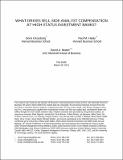What Drives Sell-Side Analyst Compensation at High-Status Investment Banks?
Published Version
https://doi.org/10.1111/j.1475-679X.2011.00417.xMetadata
Show full item recordCitation
Groysberg, Boris, Paul M. Healy, and David A. Maber. "What Drives Sell-Side Analyst Compensation at High-Status Investment Banks?" Journal of Accounting Research 49, no. 4 (2011): 969–1000.Abstract
We use proprietary data from a major investment bank to investigate factors associated with analysts' annual compensation. We find compensation to be positively related to "All-Star" recognition, investment-banking contributions, the size of analysts' portfolios, and whether an analyst is identified as a top stock picker by The Wall Street Journal. We find no evidence that compensation is related to earnings forecast accuracy. But consistent with prior studies, we find analyst turnover to be related to forecast accuracy, suggesting that analyst forecasting incentives are primarily termination based. Additional analyses indicate that "All-Star" recognition proxies for buy-side client votes on analyst research quality used to allocate commissions across banks and analysts. Taken as a whole, our evidence is consistent with analyst compensation being designed to reward actions that increase brokerage and investment-banking revenues. To assess the generality of our findings, we test the same relations using compensation data from a second high-status bank and obtain similar results.Terms of Use
This article is made available under the terms and conditions applicable to Open Access Policy Articles, as set forth at http://nrs.harvard.edu/urn-3:HUL.InstRepos:dash.current.terms-of-use#OAPCitable link to this page
http://nrs.harvard.edu/urn-3:HUL.InstRepos:13426865
Collections
- HBS Scholarly Articles [854]
Contact administrator regarding this item (to report mistakes or request changes)



